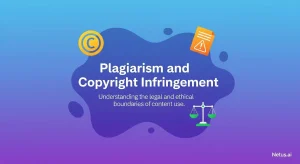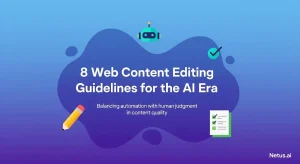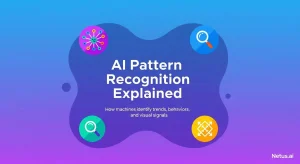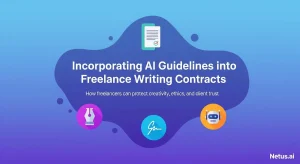
Plagiarism and copyright infringement | NetusAI
Plagiarism and copyright infringement Writers along with academic folks and students really need to steer clear of plagiarism and copyright infringement. They do this to
Free Tools to Detect AI Written Content: A Comprehensive
Guide

Content writer and editor for Netus.AI
Free Tools to Detect AI Written Content. AI-written content has become increasingly prevalent in recent years, with more and more businesses and individuals relying on artificial intelligence to generate content such as news articles, product descriptions, and social media posts. However, the rise of AI-written content has also led to concerns about authenticity and originality. How can we be sure that the content we are reading is not just a product of a machine algorithm?
Fortunately, there are several tools available that can help detect AI-written content. These tools use various techniques to analyze the language, style, and structure of a piece of content to determine its authenticity. Some tools use machine learning algorithms to compare the content to a database of known AI-generated text, while others rely on linguistic analysis to identify patterns and anomalies.
In this article, we will explore some of the most popular and effective tools for detecting AI-written content. We will discuss the features and capabilities of each tool, as well as their strengths and limitations. By the end of this article, readers will have a better understanding of how to identify AI-generated content and ensure that the content they are reading is authentic and original.
AI-generated text refers to the content that is created by artificial intelligence tools such as GPT-3, GPT-4, and other AI content generators. These tools use machine learning and natural language processing to analyze and understand human language patterns and generate text that mimics human writing.
AI writing tools have come a long way in the past few years. The first generation of AI writing tools was limited in its capabilities and could only generate simple sentences and paragraphs. However, with the advancements in natural language processing and machine learning, the latest AI writing tools can generate complex and coherent text that is difficult to distinguish from human writing.
Detecting AI-generated content is becoming increasingly difficult as AI writing tools become more sophisticated. The main challenge in detecting AI-generated content is that it can be difficult to distinguish between human-written and AI-generated text. Additionally, AI writing tools are constantly evolving, making it difficult for traditional detection methods to keep up.
To combat this challenge, new detection methods are being developed that use machine learning and natural language processing to identify patterns and characteristics that are unique to AI-generated content. These methods are constantly evolving and improving, but it remains to be seen whether they will be able to keep up with the rapid pace of AI writing tool development.
Overall, understanding AI-generated content is crucial for developing effective detection methods and staying ahead of the curve in the fight against fake and misleading content.
AI detection tools are designed to detect AI-generated content with high accuracy and precision. The accuracy of these tools is determined by their ability to distinguish between human-written and AI-generated content. False positives can be a concern, but the best AI detection tools are able to minimize these instances.
The ability to detect AI-generated content in multiple languages is a key feature of AI detection tools. These tools are designed to recognize patterns in language and syntax that are unique to AI-generated content, regardless of the language used.
AI detection tools are designed to be user-friendly, with intuitive interfaces that make it easy to analyze and detect AI-generated content. These tools often include features such as real-time analysis, customizable settings, and easy-to-read reports.
Overall, AI detection tools are an essential tool for anyone looking to detect AI-generated content. With their high accuracy and precision, support for multiple languages, and user-friendly interfaces, these tools provide an effective solution for identifying fake or misleading content. By using an AI checker, individuals and organizations can ensure that they are only consuming and sharing accurate and trustworthy information.
There are several free AI content detection tools available that can help detect AI written content. These tools can be used to check for plagiarism, originality, and authenticity of content. This section covers two types of free AI content detection tools: open-source AI detectors and browser extensions and plugins.
Open-source AI detectors are free software tools that use artificial intelligence algorithms to detect AI written content. Some popular open-source AI detectors include Originality.ai and Copyleaks. These tools use machine learning algorithms to analyze text and compare it with a vast database of content to detect similarities and plagiarism.
Originality.ai is an open-source tool that uses deep learning algorithms to detect plagiarism and originality of text. It can also identify the authorship of a piece of content and provide a similarity score. This tool is easy to use and provides accurate results.
Copyleaks is another open-source tool that uses machine learning algorithms to detect plagiarism and originality of text. It can analyze text in multiple languages and provide a detailed report on the authenticity of content. This tool is widely used by educators, writers, and publishers to check the originality of their content.
Browser extensions and plugins are free tools that can be added to web browsers like Chrome and Firefox to detect AI written content. Some popular browser extensions and plugins include Grammarly, Turnitin, and Plagiarism Checker X.
Grammarly is a popular browser extension that uses artificial intelligence algorithms to check for grammar and spelling errors in text. It can also detect plagiarism and provide suggestions for improving the quality of content. This tool is widely used by writers and bloggers to improve the readability and originality of their content.
Turnitin is a browser plugin that uses machine learning algorithms to detect plagiarism and originality of text. It can analyze text in multiple languages and provide a detailed report on the authenticity of content. This tool is widely used by educators and students to check the originality of academic papers and assignments.
Plagiarism Checker X is a browser plugin that uses artificial intelligence algorithms to detect plagiarism and originality of text. It can analyze text in multiple languages and provide a detailed report on the authenticity of content. This tool is widely used by writers, publishers, and educators to check the originality of their content.
In conclusion, there are several free AI content detection tools available that can help detect AI written content. These tools can be used to check for plagiarism, originality, and authenticity of content. Open-source AI detectors and browser extensions and plugins are two types of free tools that can be used for this purpose.
To ensure the accuracy of AI content detection tools, it is important to follow a set of best practices. These include:
To maximize the efficacy of AI detectors, it is important to integrate them into content workflows. This can include:
By following these best practices and integrating AI detectors into content workflows, companies can maximize the efficacy of their AI content detection tools and ensure that their content is authentic and free from AI-generated content.
One of the key limitations of using free tools to detect AI-written content is the possibility of false positives. False positives occur when a tool incorrectly flags content as AI-generated when it is actually human-written. This can happen if the tool is not trained on a diverse enough dataset or if it is not sophisticated enough to distinguish between different writing styles.
To minimize the risk of false positives, it is important to use multiple tools and to manually review any content that is flagged as AI-generated. It is also important to keep in mind that even if a piece of content is flagged as AI-generated, it does not necessarily mean that it is not original work.
The use of AI-generated content raises ethical concerns and questions about academic integrity. If content is generated by AI, to what extent can it be considered original work? Should AI-generated content be given the same credibility as human-written content?
Furthermore, the use of AI-generated content in academic settings can potentially lead to academic misconduct if the content is not properly attributed or if it is used to deceive others. It is important for individuals and institutions to consider these ethical implications and to use AI-generated content responsibly.
Overall, while free tools can be a useful starting point for detecting AI-generated content, it is important to approach their results with caution and to consider the limitations and ethical considerations involved.

Plagiarism and copyright infringement Writers along with academic folks and students really need to steer clear of plagiarism and copyright infringement. They do this to

5 Tips and strategies for mobile content marketing Mobile content really matters a lot these days. Pretty much 98 percent of adults in the U.S.

8 Web content editing guidelines for the AI era Editing web content turns out to be pretty tough, especially when generative AI gets involved in

AI pattern recognition explained Pattern recognition in AI really forms the backbone of what we see in artificial intelligence today. It allows machines to spot

Incorporating AI guidelines into freelance writing contracts With AI content prevalent and ranking high on Google, freelance writing contracts must include AI guidelines. This is

Eight best practices for content SEO Content has to show up and grab attention if it wants to do well. Content SEO takes care of
@ 2024 Netus AI.